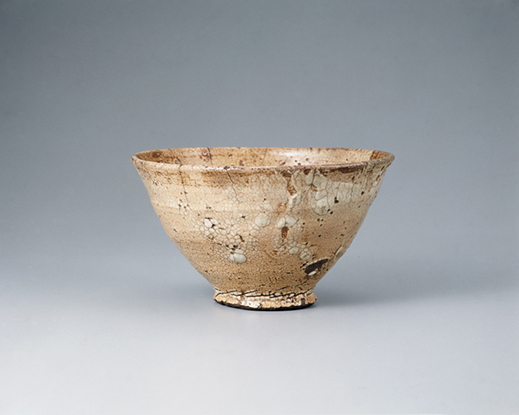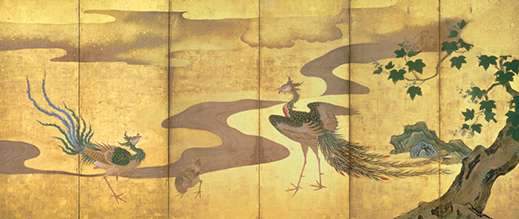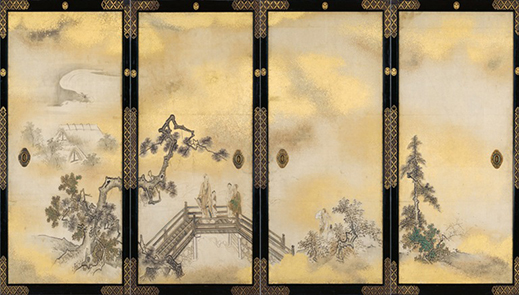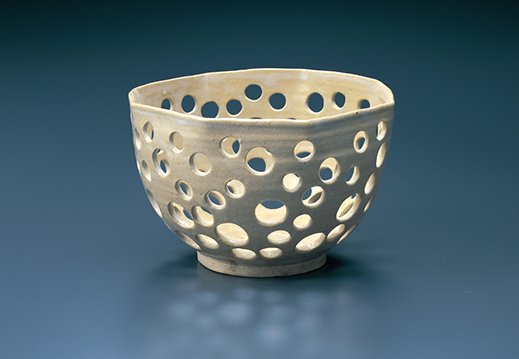 |
Focus features two in-depth reviews each month of fine art, architecture and design exhibitions and events at art museums, galleries and alternative spaces around Japan. The contributors are non-Japanese residents of Japan. |
|
|
 |
 |
 |
The Kan'ei Era: Cultivating an Aristocratic Splendor
J.M. Hammond |
 |
The Kan'ei exhibition room. Left: Nonomura Ninsei, Bowl with Pierced Circle Design and White Glaze, Edo period, 17th century, Miho Museum. Right: Kano Tan'yu, Paulownia and Phoenixes, pair of six-panel screens, Edo period, 17th century, Suntory Museum of Art. |
The refined cultural production associated with Japan's ruling elites during the early Edo period (1603-1867) is the theme of a new exhibition at the Suntory Museum of Art in Tokyo.
As exhibition titles go, Kan'ei Elegance: Edo-Period Court Culture and Enshu, Ninsei, and Tan'yu is not the snappiest, so some unpacking of the ideas it touches on would be in order here. The show focuses on a slice of time early in the Edo period, when a new cycle in the Chinese zodiac established the start of the Kan'ei era, in February 1624. The title places the imperial court at the center of developments, although the culture it promoted was not unconnected with the court of the shogun, who, at the time, wielded ultimate power in Japan.
The title also highlights the names of three key artists of the day -- Kobori Enshu, Nonomura Ninsei, and Kano Tan'yu -- although other notable names make their appearance, such as Hon'ami Koetsu and Tawaraya Sotatsu.
 |
|
Koido Tea Bowl, known as Rokujizo, Korea, Joseon dynasty, 16th century, Sen-oku Hakukokan Museum Tokyo (shown from 14 February to 12 March only). |
Defining Kan'ei culture, however, is more complicated. To brutally oversimplify, it has a different focus from the wabi aesthetic of the preceding Momoyama culture, associated with the samurai, and from the vibrant style of the later Genroku culture, typified by Rimpa school artists such as Ogata Korin. Instead, Kan'ei culture preferred a subdued form of beauty, hinted at by popular terms of the day such as miyabi (elegance) or kirei (beautiful). The exhibition Kan'ei Elegance attempts to introduce this aesthetic by bringing together almost 150 objects mainly from the Kan'ei era, including painted screens, sliding doors, scrolls, tea bowls, tea ceremony utensils and more.
This renewed cultivation of a courtly culture was made possible as centuries of internal military conflict came to an end with the start of the Edo period and the founding of the Tokugawa shogunate, which chose Edo (present-day Tokyo) as the seat of government. The imperial family remained in the official capital of Kyoto; at the start of the Kan'ei era it was headed by the emperor Gomizuno (1596-1680), who is introduced early on. Rather than using the strict dates of the era, which officially ended in 1644, the exhibition explores Kan'ei as a culture that flourished until Gomizuno's death in 1680.
Although Chinese culture held great sway with the elites, Gomizuno took the classical court culture of Japan's own Heian period (794-1185) as inspiration. The emperor was a cultured man, accomplished in the arts of tea ceremony, waka poetry, ikebana, and calligraphy. His penmanship can be seen on a scroll featuring his portrait. The work is attributed to his son, Gyojo, although Gyojo's work may be limited to the figure's head -- the body and clothes are believed to have been painted by Kano Tan'yu (1602-1674), a member of the famed Kano School of artists. Gomizuno also put his brush to several scrolls on display here.
 |
|
Kano Tan'yu, Paulownia and Phoenixes, pair of six-panel screens (right-hand screen), Edo period, 17th century, Suntory Museum of Art. |
Gomizuno abdicated in 1629, and the throne was passed on to his daughter Okiko, who became the empress Meisho. He continued his cultural activities, however, presiding over a salon where courtiers, merchants and samurai could mingle and enjoy aesthetic pursuits, as another aspect of Kan'ei culture was the increasing interaction of people from various backgrounds. As central as Gomizuno is to the story of Kan'ei, the era closely aligns with the period when Tokugawa Iemitsu ruled as the third Tokugawa shogun (1623 to 1651).
With all this talk of the elegance and cultural refinement of court life, it is easy to lose sight of the fact that, despite the end of inter-clan warfare, the Kan'ei era was in many ways one of the most brutal times in Japanese history. Iemitsu ordered the persecution of Christians and was responsible for the closed-country policy known as sakoku. It was during the Kan'ei era, for example, that a Spanish ship from Macau arrived in Nagasaki, only for all 61 on board to have their heads cut off and displayed on poles.
Iemitsu's grandfather Tokugawa Ieyasu was the founder of the Tokugawa shogunate and had built Nagoya Castle to provide a refuge from attacks from the direction of Osaka. In his day, Iemitsu used the castle as a place of rest en route between Edo and Kyoto. By that time the castle was under the control of Tokugawa Yoshinao, one of the younger sons of the late Ieyasu. On display here from the castle are fusuma (sliding door) panels from the shogun's accommodation hall, the Jorakuden, which Yoshinao had Kano Tan'yu paint with a scene of Han-dynasty noblemen crossing a bridge. With this symbolic imagery, Yoshinao likely intended to compare Iemitsu with the greatest of Chinese leaders.
 |
|
Kano Tan'yu, Fusuma Panels from the Nagoya Castle Jorakuden, "Gentleman Crossing a Bridge" from the Illustrated Mirror of Emperors (Important Cultural Property), Edo period, dated 1634, Nagoya Castle Office (shown from 14 February to 12 March only). |
As noted earlier, Chinese culture was held in great esteem in courtly circles, and the gradual acceptance of Japanese tastes is an undercurrent that runs through the exhibition. The practice of drinking tea came to Japan from China, and featured prominently throughout the show are tea bowls, tea caddies, and other associated implements. Many came from China or Korea and were so highly regarded that Japanese artists and artisans began copying them in earnest. One exhibit features 19 tea caddies of assorted shapes and designs, copied from Chinese models. The collection was in the possession of the Konoe family of nobles close to the imperial throne.
Also on display are copies of tea bowls from Korea, made by the master potter Nonomura Ninsei after he opened his own kiln in Kyoto. Ninsei, however, was not satisfied with merely copying the original Korean designs: he added his own original touches, such as deliberately leaving a fingerprint in the glaze or squashing the rim to make an interesting distorted shape.
 |
|
Nonomura Ninsei, Bowl with Pierced Circle Design and White Glaze, Edo period, 17th century, Miho Museum. |
The attempt to go beyond the original models for these aesthetic and cultural practices and to promote an indigenously Japanese aesthetic of elegance can be seen later in the work of the aristocrat and artist Kobori Enshu (1579-1647), who was asked by Iemitsu to hold a total of three tea ceremonies.
Customarily, the hanging scroll chosen for display in a ceremony would have been by a Chinese master poet-calligrapher, but Enshu chose a scroll by the Heian-period poet Fujiwara no Teika. By harking back to a previous golden age of Japanese court culture, Enshu deliberately upset tradition and helped initiate the move toward securing for Japanese cultural achievements the same kind of esteem accorded to those of China. The scroll is actually a commentary in letter form on a poetry collection, and includes a quote from a poem by Ki no Tsurayuki that begins with the line Sakura chiru ("Cherry blossom is falling"). For that reason it is known as the Sakura chiru scroll.
Considering the exhibition's relatively narrow and specific scope, Kan'ei Elegance successfully manages to present a wide range of fascinating objects that help put this somewhat lesser-known era of Japanese history and artistic production into perspective.
 |
|
 |
 |
J.M. Hammond
J.M. Hammond researches modernity in Japanese art, photography and cinema, and teaches in Tokyo, including as a faculty lecturer in the English department at Meiji Gakuin University. He has written about art for The Japan Times for over a decade. His essays include "A Sensitivity to Things: Mono No Aware in Late Spring and Equinox Flower" in Ozu International: Essays on the Global Influences of a Japanese Auteur (Bloomsbury, 2015) and "The Collapse of Memory: Tracing Reflexivity in the Work of Daido Moriyama" for The Reflexive Photographer (Museums Etc, 2013) [reprinted in the same publisher's 10 Must Reads: Contemporary Photography (2016)]. He has given various conference papers, including at the University of Hong Kong and the University of Oxford. |
|
 |
|